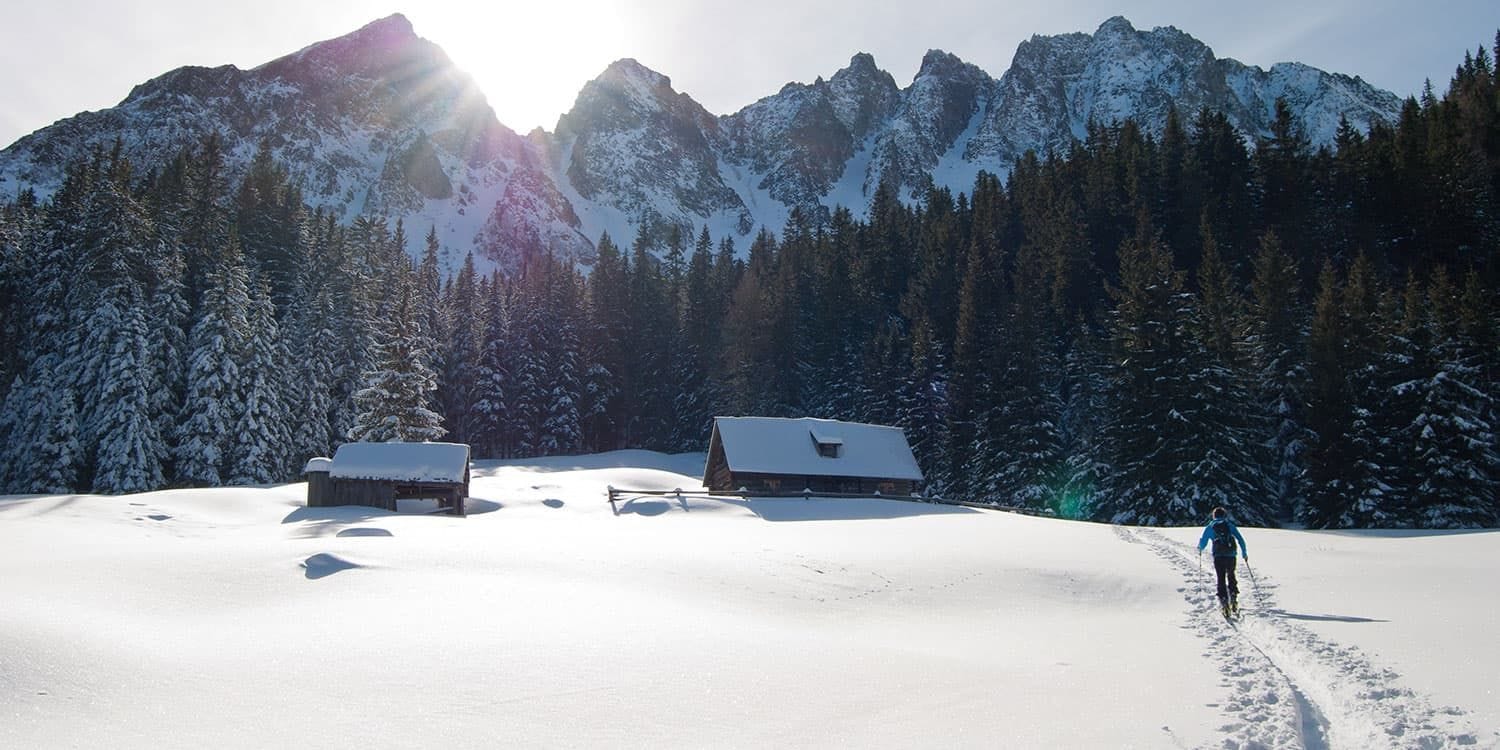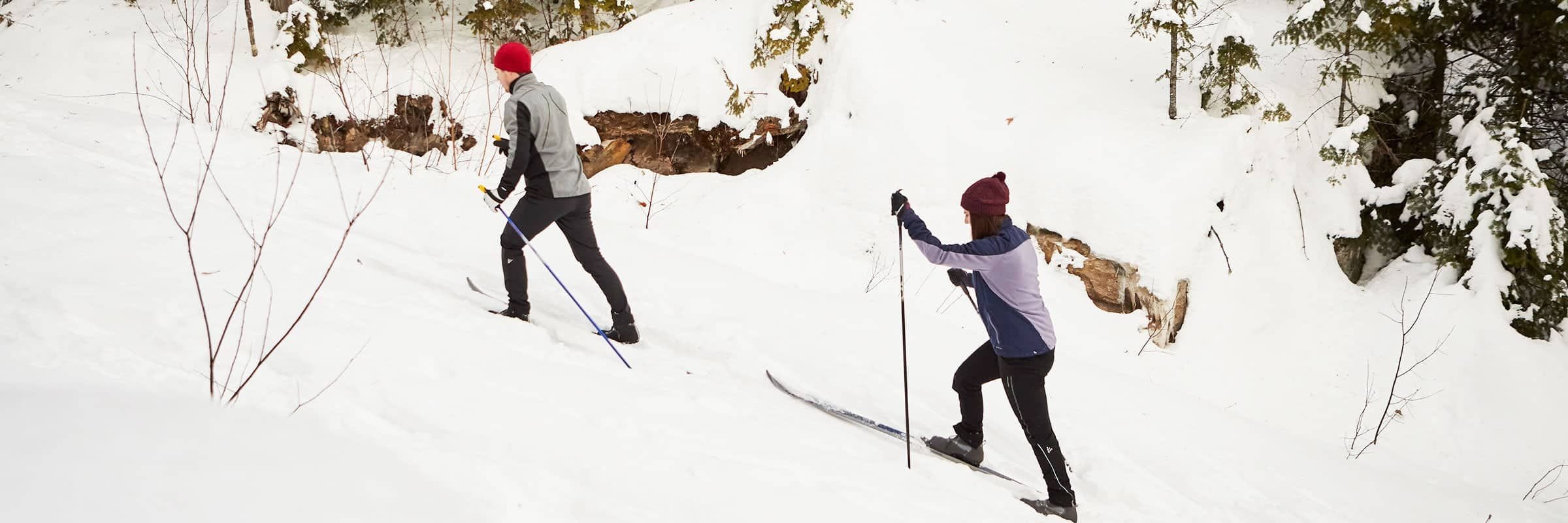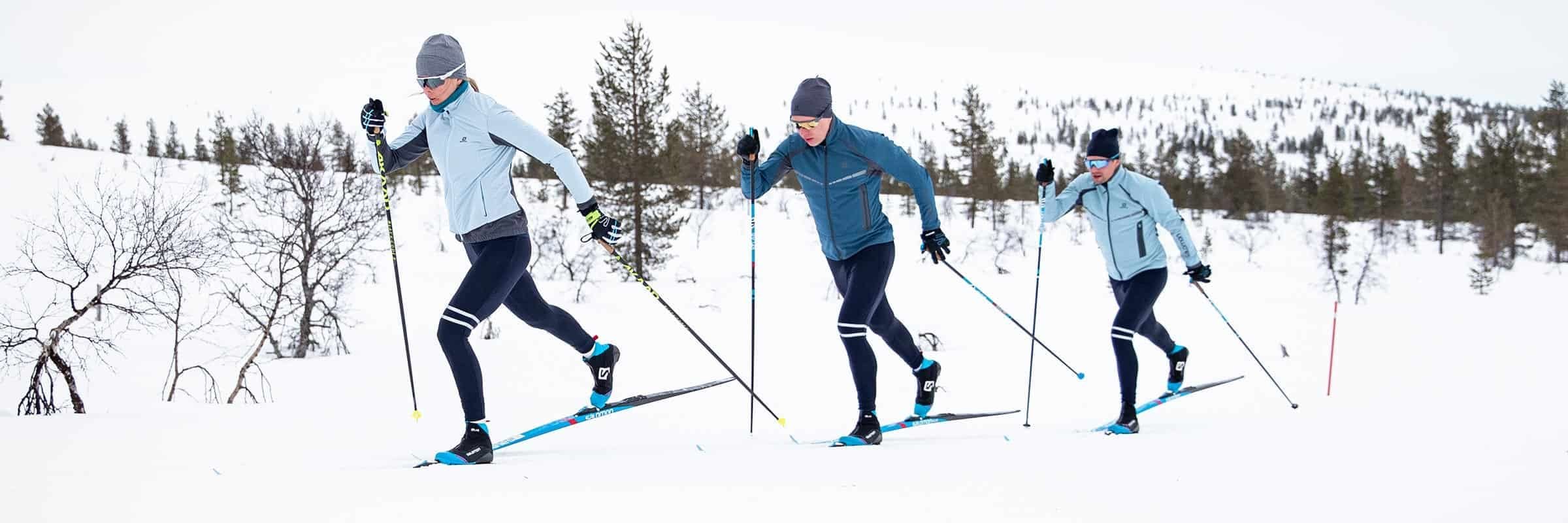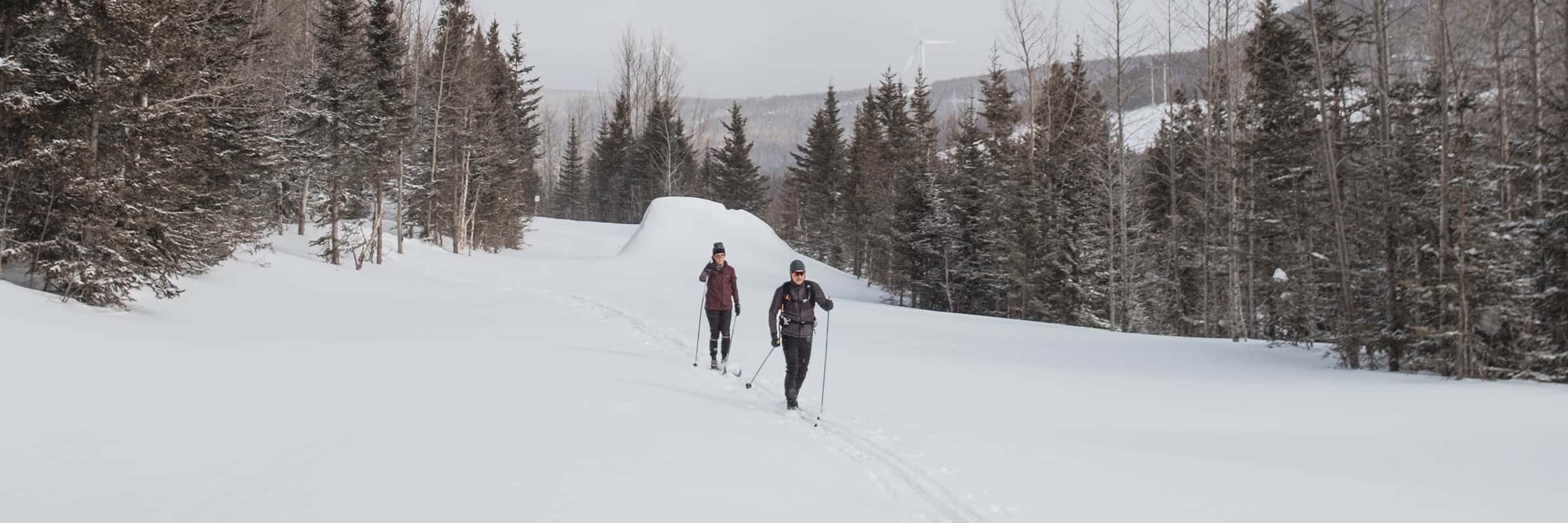Wednesday morning, 7:15 AM. The sun struggles to break through the clouds scattered here and there in the dawn sky. In just a few minutes, over to the east, it’ll suddenly set the horizon ablaze, and I’ll be able to turn off the headlamp lighting my way along the cross country ski trail. In less than two hours, I’ll be back at work, at home in front of my computer. What makes a sane person leave the warmth of their bed so early, brave the biting cold, all to to get lost in the woods at this time of night while cross country skiing?
I’ve long since realised, intuitively, how beneficial this sport is for my mental health and mood, which suffer a lot on short, darker winter days. In fact, there are many studies that prove the majority of cross-country skiers who practice the sport on a regular basis experience much less winter depression.
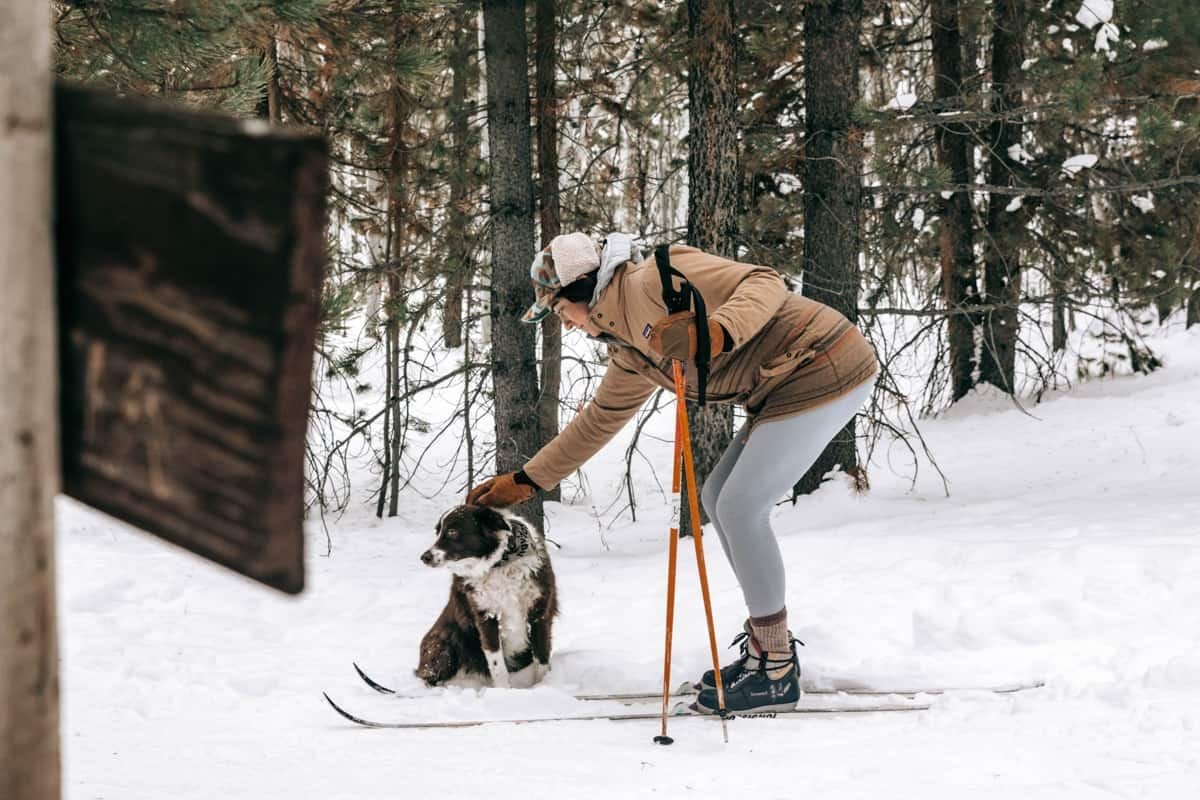
IN PRAISE OF the SLOW
“I want to go downhill skiing!” I told my mother one fine December day when I was twelve. All my friends were doing it. The idea of whipping down the slopes at full speed, wind in my hair, cheeks frozen from the cold, filled my head with crazy exhilaration. “You’re going to hurt yourself,” she deadpanned, dispelling my image of LEMans-like excitement with one of me crumpled head-first against a fir tree. “We’re going to buy you some cross-country skis, then you’ll try it with your dad.”
Cross-country skiing? Slide along flat ground, without the slightest notion of pleasure? The slowest sport in the history of mankind, worse even than snowshoeing? And with my dad? It was a one=way ticket to laughing stock fame of elementary school.
And yet…cross-country skiing is probably the most complete sport you can do in winter, even more thorough than running, because your arm work is critical for thrust and balance. It’s a sport that’s worth it in every way, and not just this year because you have nothing else to do.
Cross country skiing for health
Even if holiday parties didn’t happen, everyone still finds a way to go overboard and mix in an unhealthy does of sloth—if only because it was our only consolation.
Well then, there’s no better way to get back into shape than cross-country skiing, which works almost every muscle found from your ankles to your shoulders. Cross-country skiing is one of the best exercises for cardiovascular health and is a must in Canada’s backcountry, allowing endurance work over many lightly-populated kilometres.
Even though cross-country skiing is a complete endurance sport, it’s considered to be less hard on the body than winter running. You recover more easily and experience less stiffness the next day. I go skiing several times a week. A fifteen minute winter run wears me out to the point it becomes a once-a-month thing.
How to cross country ski—beginner's tips
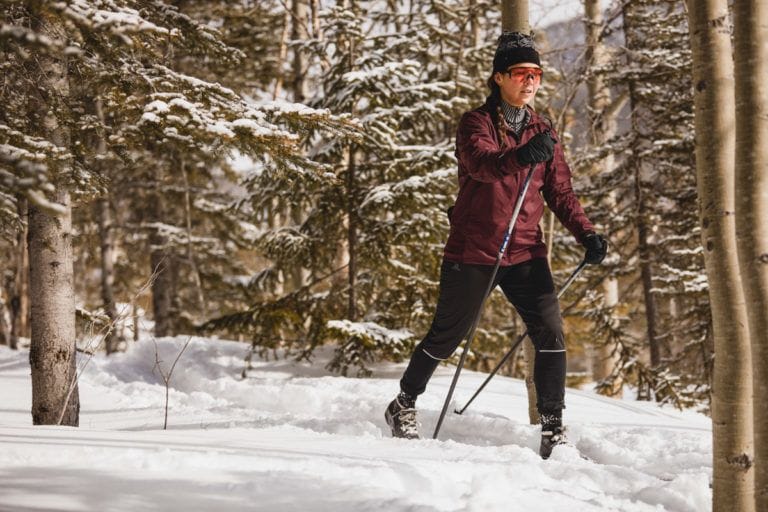
Two techniques: the classic and the skate step
Cross-country skiing is not downhill skiing on flat ground. The skis are pointed and much narrower, and the techniques are completely different.
The first one, the classic step, is by far the most common. Practised on groomed slopes, but also off-piste for the more rebellious, the classic step offers an excellent first step to cross-country skiing, and is suitable for both serious skiers and beginners alike. Easy to understand and simple to put into practice, it consists of putting one ski in front of the other so as to slide on the snow, and is close to walking or striding. Your poles help push you forward, but are mainly helping your balance. Most of the thrust comes from the legs, the weight mainly on your toes, the body leaning slightly forward.
If you’re overtaken by high-speed skiers in fluorescent yellow tights, most likely they are practising the skate style. More commonly known as skating, this technique consists of making a double-push movement with your poles with each stride. The skis are slightly shorter than classic cross-country skis, giving a skating impression (hence the name). There are other ways to do this, but for experts only – take it easy.
How do you choose cross-country skis? Keep it simple.
Scale skis, skins, waxing techniques, rigorous maintenance…good thing for you, learning to love cross country skiing doesn’t mean learning a whole new lexicon. Here’s a tip: choose cross-country skis with scales.
A flake ski does not require maintenance, especially if you are a beginner. These have textured surfaces providing good grip on uphill slopes and more than acceptable glide. Perfect for beginners or for those who ski on mechanically-worked slopes.
Skis with skins are making a big comeback thanks to new technology. An excellent compromise, skins offer the best combination of grip, glide and ease of maintenance.
And finally, purists and athletes use waxing skis. Wax is applied underneath the ski to make it perform better. You should know that the type of wax varies according to the conditions, the type of tour, the weather, and more. It’s also advisable to dress right…
What should I wear for cross country skiing?
Where Oakley, Burton and Helly Hansen are alpine skiing icons, Salomon, Rossignol, Garneau and Sportful reign over the snowy undergrowth and the groomed tracks.
Every winter, I see too many big ski coats, snow pants and oversized mittens on cross country skiers. As we said, cross-country skiing is an endurance sport—you’re going to get very warm very quickly. It’s best to wear layers, which you can add or remove depending on how you feel.
Personally, I swear by a Merino wool base layer (check out icebreaker or Kari Traa) which retains my body heat and keeps me perfectly dry, no matter the weather or my core temperature.
First step-Baselayers
- Lorem ipsum dolor<\/li>
- Lorem ipsum dolor<\/li>
- Lorem ipsum dolor<\/li><\/ul>","_id":"e571ac2"},{"feature":"
- Lorem ipsum dolor<\/li>
- Lorem ipsum dolor<\/li>
- Lorem ipsum dolor<\/li><\/ul>","_id":"7d70dbf"}],"single_product_id":null,"cta_1_url":null,"cta_2_url":null,"credit":null,"limit":null,"collection_link":null}
After my base layer it’s time for a fairly thin coat, lightly-lined, but above all with good wind protection. The Sportful and Salomon coats do the job perfectly. The idea is not to find the warmest possible get-up, but to achieve a balance between freedom of movement, warmth and shielding from the wind.
Wind-cutting jackets
- Lorem ipsum dolor<\/li>
- Lorem ipsum dolor<\/li>
- Lorem ipsum dolor<\/li><\/ul>","_id":"c339fdc"},{"feature":"
- Lorem ipsum dolor<\/li>
- Lorem ipsum dolor<\/li>
- Lorem ipsum dolor<\/li><\/ul>","_id":"94b2ef7"}],"single_product_id":null,"cta_1_url":null,"cta_2_url":null,"credit":null,"limit":null,"collection_link":null}
Stay hydrated
When hiking in the summer, you can opt for a hydration bag or a backpack in which you can carry a water bottle. Or a flask, of course—I won’t say which I prefer.
Cross country skiing doesn’t make you as thirsty as quickly as a summer hike, but the danger of dehydration is still there. And with relay stations likely to be closed this year due to the pandemic, it’s best to plan ahead.
cross country skiing safety tips
What should I do if I'm too cold to ski?
Don't wait before adding or removing layers! If you're too cold, add an intermediate layer that you're carrying in your bag (yes, carry one!). And if you're too hot, take it off, as excessive perspiration can eventually cool you down considerably.
Where should I try cross country skiing?
Know your terrain! Make sure you know the track in front of you, especially if you don't bring your smartphone. You won't want to venture out on a 15 km one-way trail if you're just a beginner. Likewise, pay special attention to the level of difficulty. If you're not ready for big downhill runs or difficult climbs, choose an easier trail.
What if I fall?
Experienced skiers know how to fall when cross-country skiing. Try to fall on your side, and don't use your poles to hold yourself back! After the fall, make sure you move to the side of the trail. Sometimes your skis may cross each other, causing you to fall, and stay crossed, preventing you from moving to move around. The easiest way to do this is to remove a ski to move to the side, and then put it back on after getting up. And don't worry: falls are normal in cross-country skiing!
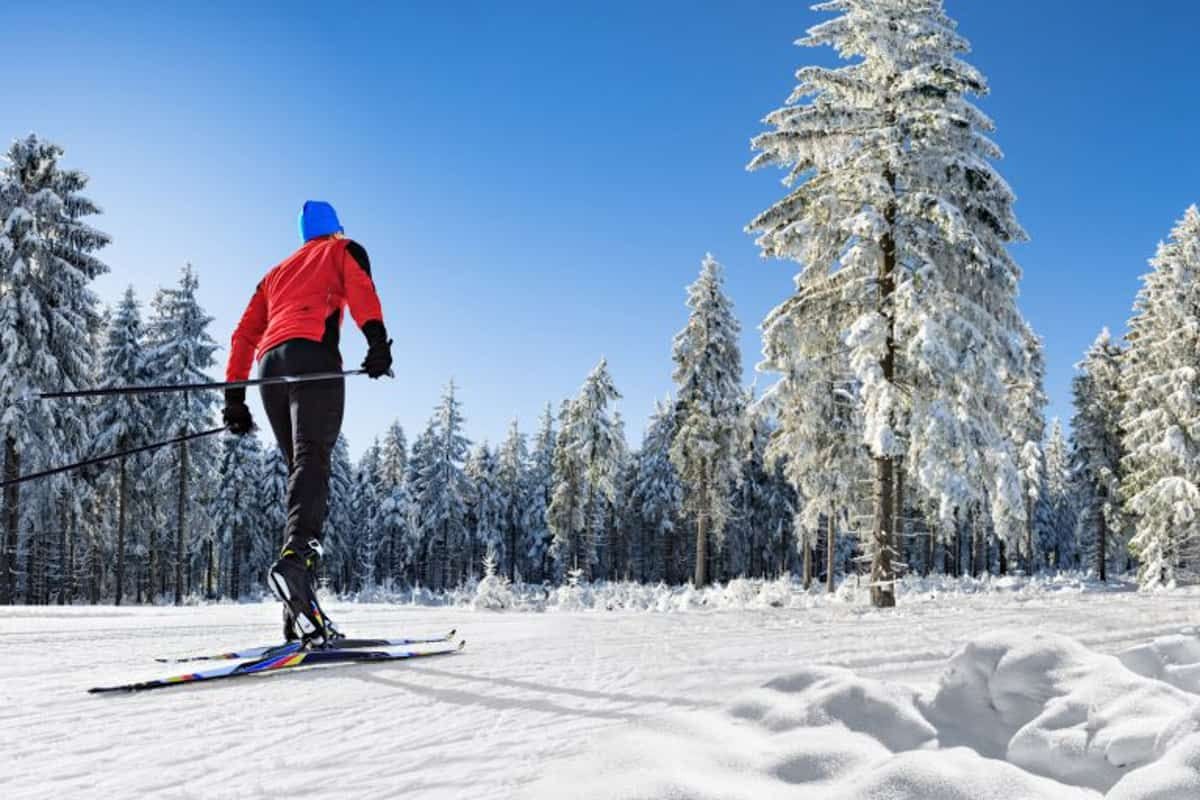
In the woods, the north wind fades, and only silence remains. A deep, icy silence, broken only by the sliding of your skis against the snow. Here, in the heart of a frozen ocean of pine and birch trees, the appeal of cross country skiing is truly understood.
This return to our common roots is an excellent way to get closer to nature. Take the time to listen. Breathe. And forget, for a moment, the frantic rhythm of our daily life.
A piece of advice—if you know where you’re going, don’t bring your phone with you. The encounter with nature is enough. And the dozen or so pictures of deer are never really necessary.
Where to cross country ski in Quebec

My favourite place? Gatineau Park. With its many kilometres of trails and hills, in the heart of the forest, it’s a dream spot for lovers of speed and nature.
Near Montreal? We know Saint-Bruno, Oka, etc., but the more difficult access in this pandemic year is discouraging for some. When in the city, Mount Royal is an excellent option. A favourite place: the Montagne coupée, in Lanaudière, barely an hour’s drive from the metropolis. A paradise of nature, slopes to descend at full speed, and the most welcoming employees in the industry.
To get away from the crowds? The Parc régional des Grèves, between Sorel and Contrecoeur. A magnificent and well-kept park, kilometres on flat ground (few slopes) in the middle of the forest, I hesitated for a long time before including it here since it is a well-kept secret. But I trust that you will not all come and take the last parking space.
Conclusion
Life does things well. If I hadn’t listened to my mother so many years ago, I might be standing in line for hours at Mont Saint-Anne or Bromont right now. On the contrary, I am often alone in the woods, with my skis and my flask—excuse me, my water bottle.
If you try it out and like it, keep it up. Don’t take the end of the pandemic as a signal that you have to go back to your old habits. Create new ones, you won’t regret it in the least.


